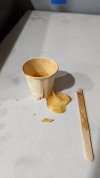- Joined
- Apr 3, 2011
- Messages
- 5,938
I've been using blade pro... In my tests it's slightly stronger than gflex.
The problem is that when I wanna re-do something and remove a handle (from a hidden tang knife for example) it won't let go.
I heated a leftover cured sample I had up to 450f after trying to get a blade out of a hidden tang knife I made at 350f (wasn't working).
This stuff stayed hard and barely pliable at that temp even though it turned brown. When I called technical support for system three they said it's designed to be permanent and heat won't loosen it up.
Any body tried any tests with what you have/use?
The problem is that when I wanna re-do something and remove a handle (from a hidden tang knife for example) it won't let go.
I heated a leftover cured sample I had up to 450f after trying to get a blade out of a hidden tang knife I made at 350f (wasn't working).
This stuff stayed hard and barely pliable at that temp even though it turned brown. When I called technical support for system three they said it's designed to be permanent and heat won't loosen it up.
Any body tried any tests with what you have/use?

Last edited:
